Stewart J. College Algebra: Concepts and Contexts
Подождите немного. Документ загружается.

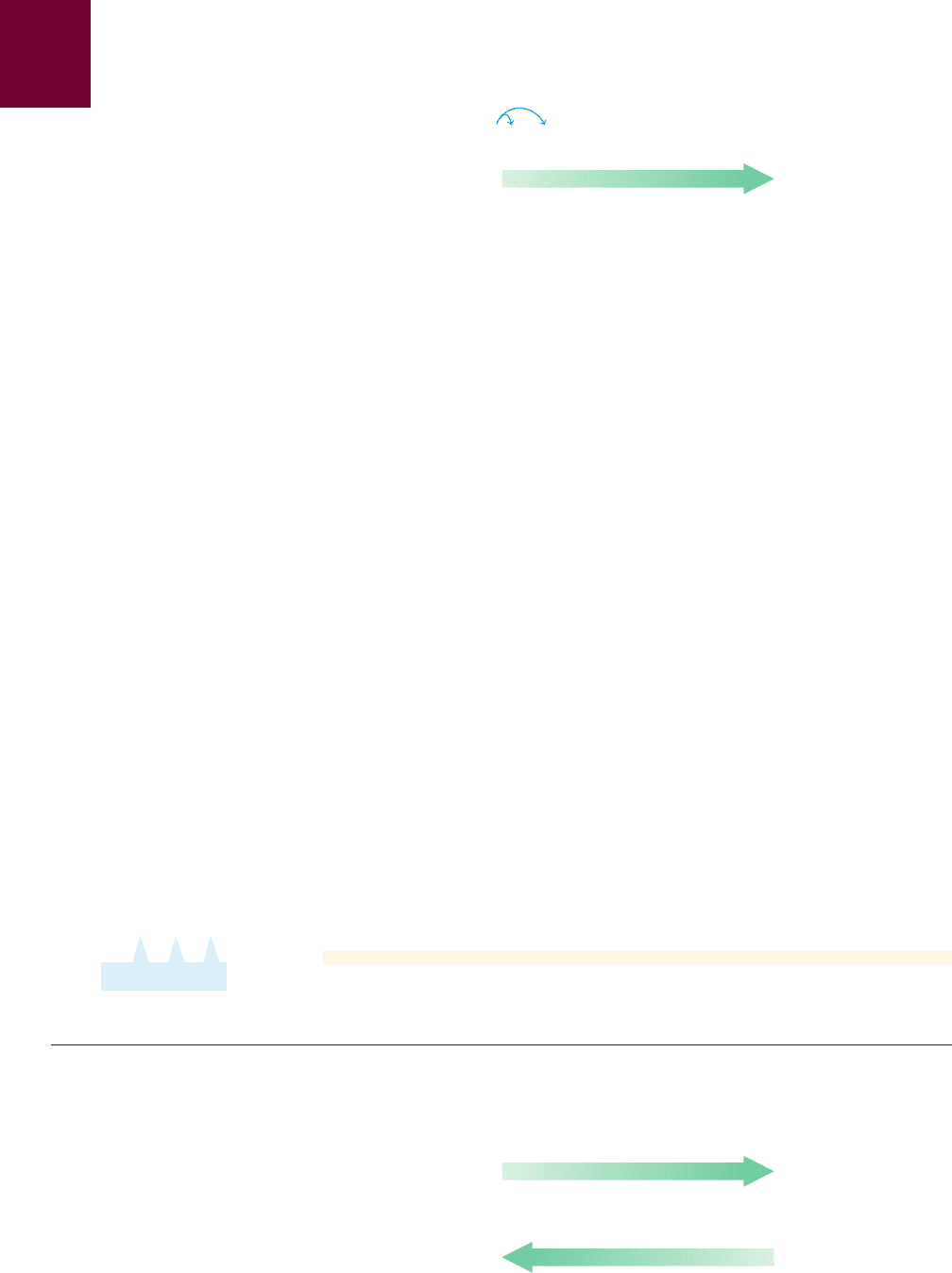
T4 ALGEBRA TOOLKIT A
■
Working with Numbers
example
3
Using the Distributive Property to Expand
Expand the products using the Distributive Property.
(a)
(b)
(c)
Solution
(a) We use the Distributive Property.
Distributive Property
Simplify
(b) The minus sign is the same as multiplying by .
Distributive Property
Simplify
Notice how the negative sign outside the parentheses switches the signs of the
terms inside the parentheses.
(c) The Distributive Property is valid for three or more terms.
Distributive Property
Simplify
■ NOW TRY EXERCISES 27, 31, AND 33 ■
= 7x
2
+ 14xy + 28x
7 x˛ 1x + 2y + 4 2= 7x
#
x + 7x
#
2y + 7x
#
4
=-2 + x
= 1- 122 + 1- 121- x2
- 12 - x 2=-112 - x 2
- 1
= ax + 5ay
a1x + 5y 2= a
#
x + a
#
5y
7x˛ 1x + 2y + 4 2
- 12 - x2
a1x + 5y2
EXPANDING
The expression inside the
parentheses in Example 3(c) has
three terms.
x + 2y + 4
x˛ 13 + 2y 2= x
#
3 + x
#
2y = 3x + 2xy
So for any numbers x and y it is true that . For instance, we
can check that this is true when x is 5 and y is 8:
Right-hand side: 3
#
5 + 2
#
5
#
8 = 15 + 80 = 95
Left-hand side: 513 + 2
#
82= 5119 2= 95
x13 + 2y 2= 3˛x + 2xy
Three terms
2
■ The Distributive Property: Factoring
Factoring is the reverse of expanding. When we factor, we use the Distributive
Property to write an expression as a product of simpler ones.
513 + x 2= 15 + 5x
EXPANDING
FACTORING

A.1
■
Numbers and Their Properties T5
example
4
Using the Distributive Property to Factor
Factor the following using the Distributive Property.
(a)
(b)
(c)
(d)
Solution
(a) The common factor in each term is 3. So we factor 3 from each term using the
Distributive Property.
Distributive Property
(b) The common factor in each term is a. So we factor a from each term using the
Distributive Property.
Distributive Property
(c) The expression is common to each term. So we factor 2x from each term
using the Distributive Property.
Distributive Property
(d) The expression 3b is common to each term. So we factor 3b from each term
using the Distributive Property (applied to the three terms).
Distributive Property
■ NOW TRY EXERCISES 35, 39, AND 43 ■
3abc + 6ab + 3bc = 3b1ac + 2a + c2
2bx + 4x = 2x1b + 22
2x
ax + 2ay = a1x + 2y2
3x + 3
#
1 = 31x + 12
3abc + 6ab + 3bc
2bx + 4x
ax + 2ay
3x + 3
In Example 4(b), a is a common
factor of the terms ax and ay.
3abc + 6ab + 3bc
ax + 2ay
To use the Distributive Property in reverse, we look for common factors of each of
the terms in the expression we are factoring.
a is a factor
of each term
3b is a factor
of each term
A.1 Exercises
CONCEPTS
1. Give an example of each of the following:
(a) A natural number
(b) An integer that is not a natural number
(c) A rational number that is not an integer
(d) An irrational number
2. Complete each statement and name the property of real numbers you used.
(a) ________________; ________________ Property
(b) ________________; ________________ Property
(c) ________________; ________________ Property
3. (a) When two numbers are multiplied together, each of the numbers is called a
________________ (term/factor). So in the product 3xy the numbers 3, x, and y are
________________.
a1b + c2=
a + 1b + c 2=
ab =
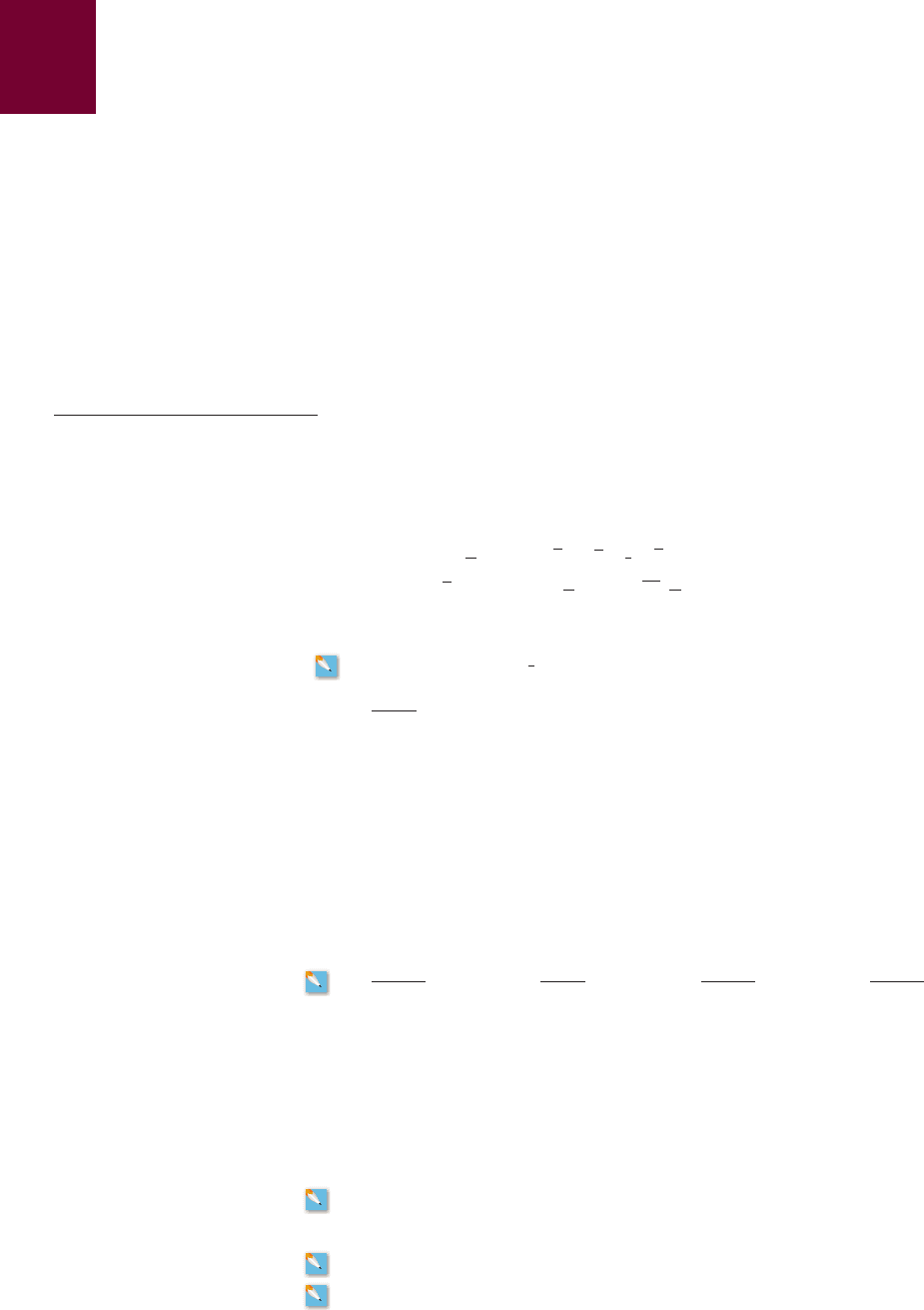
T6 ALGEBRA TOOLKIT A
■
Working with Numbers
SKILLS
(b) When two numbers are added together, each of the numbers is a
_____________ (term/factor). So in the sum the expressions 3 and xy
are
_____________.
4. (a) We use the
_____________ _____________ to expand expressions, so to
expand the expression , we multiply each term inside the parentheses by
_______, and get _______ _______.
(b) We use the
_____________ _____________ to factor. The expression
has a common factor
_______, so to factor the expression , we
factor
_______ from each term and get ______________.
5–6
■ List the elements of the given set that are:
(a) Natural numbers
(b) Integers
(c) Rational numbers
(d) Irrational numbers
5.
6.
7–10
■ Evaluate the arithmetic expression.
7. 8.
9. 10.
11–18
■ State the property of real numbers being used.
11. 12.
13. 14.
15. 16.
17. 18.
19–22
■ Evaluate the given expression.
19. 20. 21. 22.
23–26
■ Evaluate the given expression directly, then evaluate using the Distributive
Property.
23. 24.
25. 26.
27–34
■ Expand the expression using the Distributive Property.
27. 28.
29. 30.
31. 32.
33. 34. 13q - 2qr - 5r 21- 2ps24mn12p + 3pq - 2q2
- 3c16ab - 5bd2- 413ax - 2x 2
1x + 2y 271a - 3c 26
81a - 2231x + 72
- 0.3130 - 202113 - 1021- 102
120 + 142
#
53110 + 22
6 - 16
2 - 7
10 - 4
5 - 2
4 - 9
5
10 - 4
3
71a + b + c2= 71a + b2+ 7c2x13 + y2= 13 + y22x
1x + a 21x + b 2= 1x + a2x + 1x + a2b15x + 123 = 15x + 3
21A + B2= 2A + 2B1x + 2y2+ 3z = x + 12y + 3z2
2
13 + 52= 13 + 5227 + 10 = 10 + 7
1 - 23 3 - 415 - 6
#
724
5 + 7
3
- 6312 - 117 - 2
#
324
314
#
6 - 2
#
102+ 7115 - 8
#
22- 2 + 34
#
7 - 5A9 -
8
2
B4
51.001, 0.3
, - p, - 11, 11,
13
15
, 3.14, 116,
15
3
6
50, - 10, 50,
22
7
, 0.583, 17, 1.23, -
1
3
,1
3
26
ab + ac =
ab + acab + ac
+a1b + c2=
a1b + c2
3 + xy
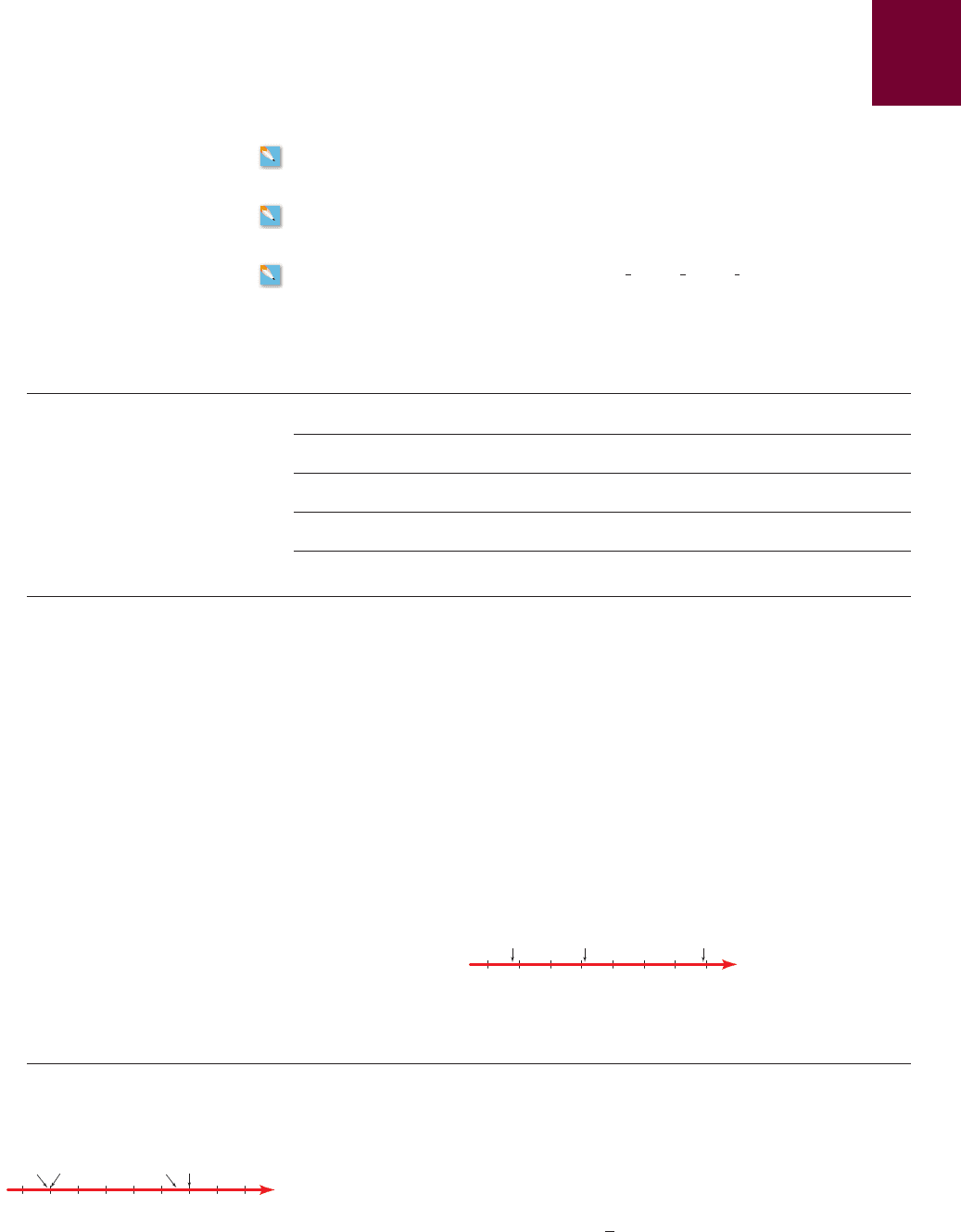
_3_4 _2 _1 0 1 2 3 4
_3_π œ∑ 22
figure 2
A.2
■
The Number Line and Intervals T7
35–42 ■ Factor the given expression using the Distributive Property.
35. 36.
37. 38.
39. 40.
41. 42.
43. 44.
1
2
abx +
1
4
aby -
1
8
abz2qrs - 6qst + 12rst
- 30xz - 90yz- 5ab + 10bc
2ax + 2ayab - 6b
- 20x + 40y- 2a - 2b
6y - 123x + 9
2
A.2 The Number Line and Intervals
2
■ The Real Line
The real numbers can be represented by points on a line, as shown in Figure 1. The
positive direction (toward the right) is indicated by an arrow. We choose an arbitrary
reference point O, called the origin, which corresponds to the real number 0. Given
any convenient unit of measurement, each positive number x is represented by the
point on the line a distance of x units to the right of the origin, and each negative num-
ber is represented by the point x units to the left of the origin. Thus every real
number is represented by a point on the line, and every point P on the line corre-
sponds to exactly one real number.
The number associated with the point P is called the coordinate of P, and the
line is then called a coordinate line, or a real number line, or simply a real line.
Often we identify the point with its coordinate and think of a number as being a point
on the real line.
- x
■
The Real Line
■
Order on the Real Line
■
Sets and Intervals
■
Absolute Value and Distance
_3 _2 _1 0 1 2 3 4
_2.2
0.1 3.9
figure 1 The real line
2
■ Order on the Real Line
The real numbers are ordered. We say that a is less than b and write if is
a positive number. Geometrically, this means that a lies to the left of b on the number
line. (Equivalently, we can say that b is greater than a and write .) The symbol
(or ) means that either or and is read “a is less than or equal
to b.” For instance, the following are true inequalities (see Figure 2):
- p 6-312 6 22 … 2
a = ba 6 bb Ú aa … b
b 7 a
b - aa 6 b
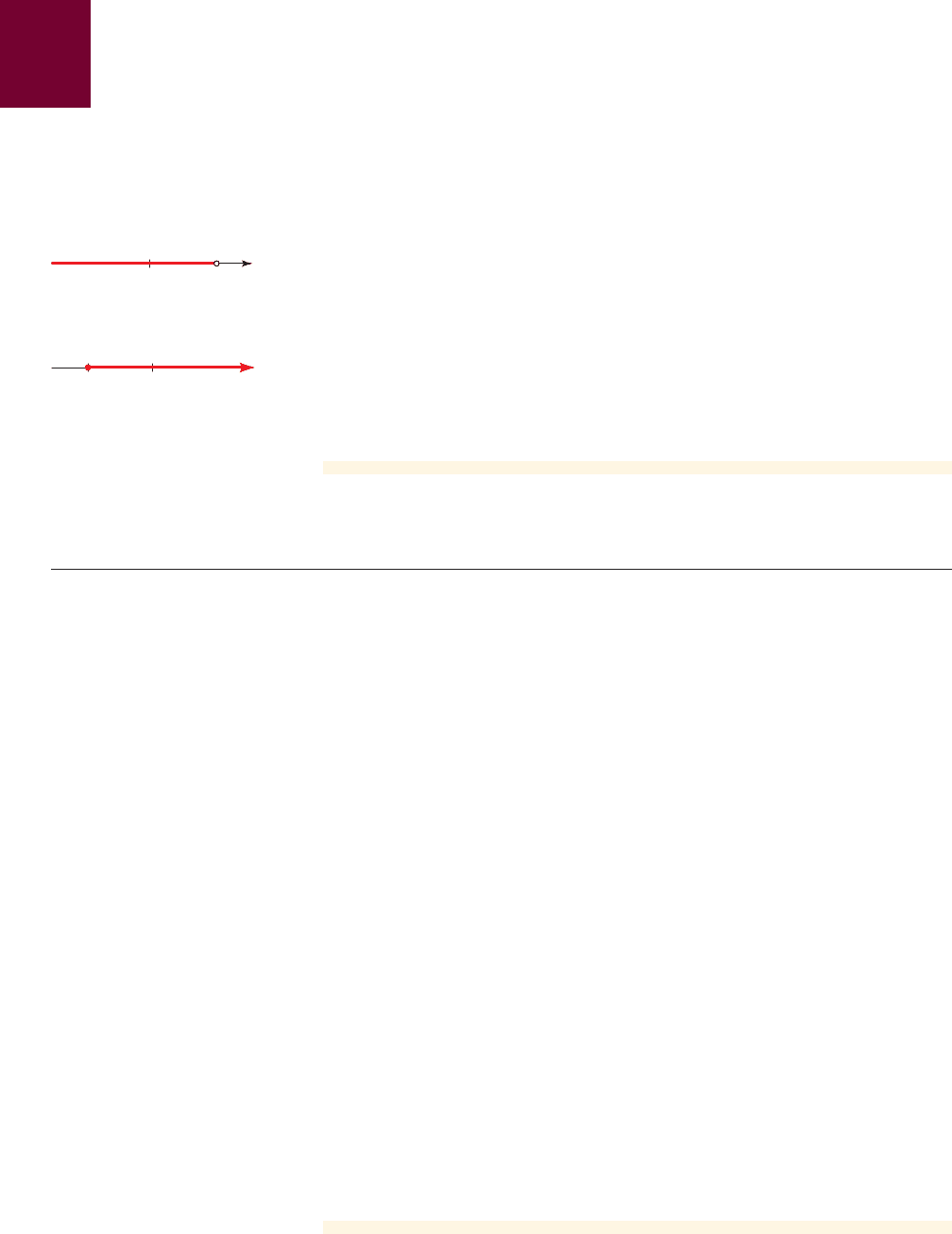
T8 ALGEBRA TOOLKIT A
■
Working with Numbers
example
1
Graphing Inequalities
(a) On the real line, graph all the numbers x that satisfy the inequality .
(b) On the real line, graph all the numbers x that satisfy the inequality .
Solution
(a) We must graph the real numbers that are smaller than 3: those that lie to the
left of 3 on the real line. The graph is shown in Figure 3. Note that the number
3 is indicated with an open dot on the real line, since it does not satisfy the
inequality.
(b) We must graph the real numbers that are greater than or equal to : those
that lie to the right of on the real line, including the number itself. The
graph is shown in Figure 4. Note that the number is indicated with a solid
dot on the real line, since it satisfies the inequality.
■ NOW TRY EXERCISES 17 AND 19 ■
- 2
- 2- 2
- 2
x Ú-2
x 6 3
_2
0
figure 4
30
figure 3
2
■ Sets and Intervals
A set is a collection of objects, and these objects are called the elements of the set.
Some sets can be described by listing their elements within braces. For instance, the
set A that consists of all positive integers less than 7 can be written as
We could also write A in set-builder notation as
which is read “A is the set of all x such that x is an integer and .”
If S and T are sets, then their union is the set that consists of all ele-
ments that are in S or T (or in both). The intersection of S and T is the set
consisting of all elements that are in both S and T. In other words, is the
common part of S and T. The empty set, denoted by , is the set that contains no
element.
⭋
S 傽 T
S 傽 T
S ´ T
0 6 x 6 7
A = 5x
0 x is an integer and 0 6 x 6 76
A = 51, 2, 3, 4, 5, 66
example
2
Union and Intersection of Sets
If , , and , find the sets , ,
and .
Solution
All elements in S or T
Elements common to both S and T
S and have no elements in common
■ NOW TRY EXERCISE 31 ■
V S 傽 V = ⭋
S 傽 T = 54, 56
S ´ T = 51, 2, 3, 4, 5, 6, 76
S 傽 V
S 傽 TS ´ TV = 56, 7, 86T = 54, 5, 6, 76S = 51, 2, 3, 4, 56
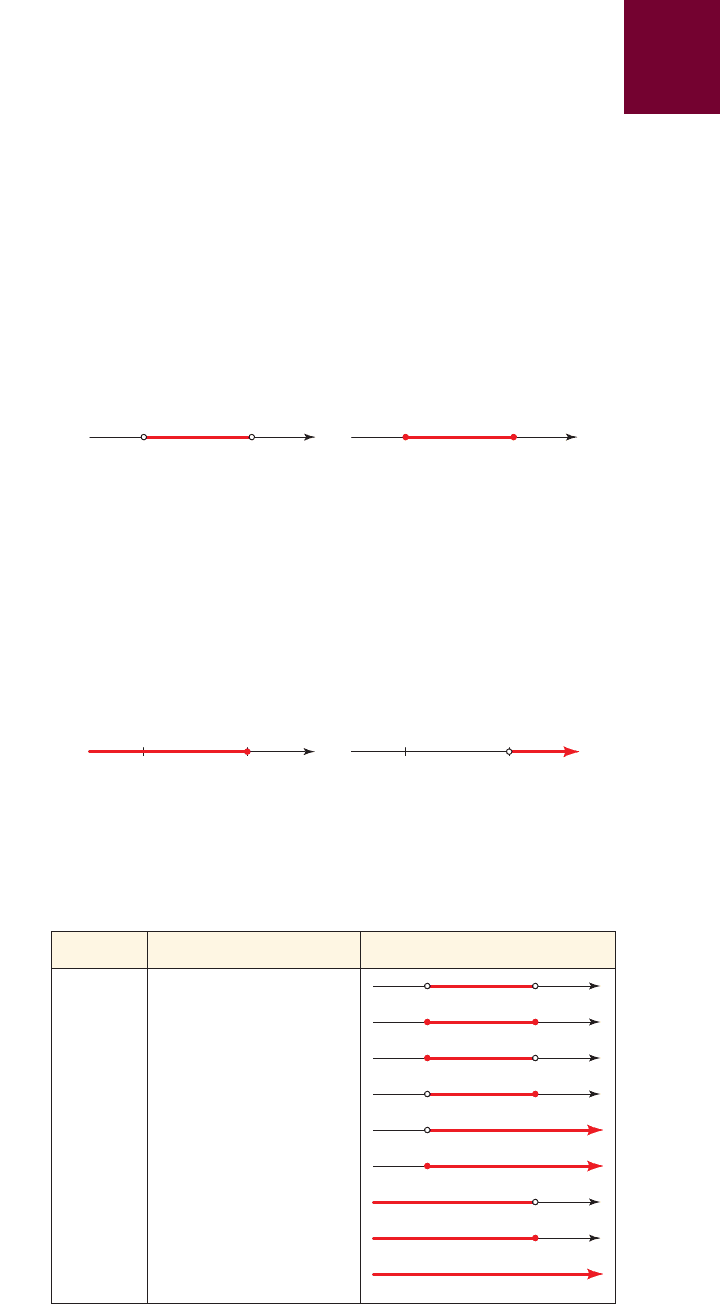
A.2
■
The Number Line and Intervals T9
Certain sets of real numbers, called intervals, occur frequently in algebra and
correspond geometrically to line segments. For example, if , then the open in-
terval from a to b consists of all numbers between a and b, excluding the endpoints
a and b. The closed interval includes the endpoints. We can write these intervals in
set-builder notation:
Open interval Closed interval
When we graph these intervals on the real line, we use a solid dot to indicate that an
endpoint is included and an open circle to indicate that an endpoint is excluded. The
graphs are shown below.
3a, b4= 5x
0 a … x … b61a, b 2= 5x 0 a 6 x 6 b6
a 6 b
We also need to consider infinite intervals. For example, all the numbers greater
than 3 form the interval . This does not mean that (“infinity”) is a number.
The notation stands for the set of all numbers that are greater than a, so the
symbol simply indicates that the interval extends indefinitely far in the positive di-
rection. Similarly, is the interval consisting of all numbers less than or equal
to 3 (the bracket on the right-hand side of the interval indicates that we include 3).
We graph these intervals on the real line.
1- q, 34= 5x 0 x … 3613, q 2= 5x 0 3 6 x6
1- q, 34
q
1a, q 2
q13, q 2
ab
ab
03
03
Table 1 lists the nine possible types of intervals. When these intervals are dis-
cussed, we will always assume that .a 6 b
Notation Set description Graph
1a, b 2 5x 0 a 6 x 6 b6
3a, b4 5x 0 a … x … b6
3a, b2 5x 0 a … x 6 b6
1a, b 4 5x 0 a 6 x … b6
1a, q 2 5x 0 a 6 x6
3a, q 2 5x 0 a … x6
1- q, b 2 5x 0 x 6 b6
1- q, b 4 5x 0 x … b6
1- q, q 2 (set of all real numbers)⺢
table 1
ab
ab
ab
ab
a
a
b
b
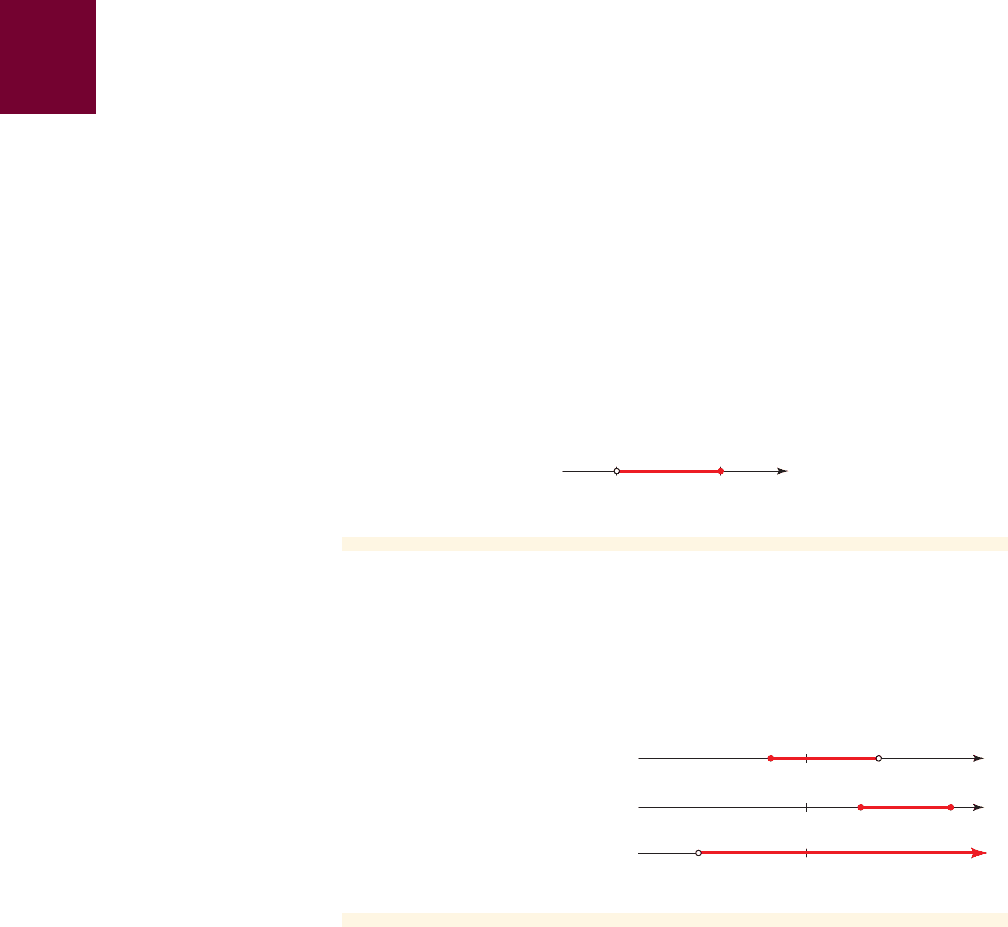
T10 ALGEBRA TOOLKIT A
■
Working with Numbers
example
3
Verbal Description of an Interval
Consider the interval .
(a) Give a verbal description of the interval.
(b) Express the interval in set builder notation.
(c) Graph the interval.
Solution
(a) The interval consists of all numbers between 2 and 5, including 5 but
excluding 2.
(b)
(c) The graph is shown below.
12, 5 4= 5x 0 2 6 x … 56
12, 5 4
example
4
Graphing Intervals
■ NOW TRY EXERCISES 35 AND 37 ■
25
_1 20
0
1.5 4
0
_3
■ NOW TRY EXERCISE 33 ■
example
5
Finding Unions and Intersections of Intervals
Graph each set.
(a) (b)
Solution
(a) The intersection of two intervals consists of the numbers that are in both
intervals. Therefore,
This set is illustrated in Figure 5.
(b) The union of two intervals consists of the numbers that are in either one
interval or the other (or both). Therefore,
= 5x
0 2 … x 6 36= 32, 3 2
11, 32傽 32, 74= 5x 0 1 6 x 6 3 and 2 … x … 76
11, 32´ 32, 7411, 32傽 32, 74
Express each interval in set builder notation, and then graph the interval.
(a) (b) (c)
Solution
(a)
(b)
(c) 1- 3, q 2= 5x
0 - 3 6 x6
31.5, 44= 5x 0 1.5 … x … 46
3- 1, 22= 5x 0 - 1 … x 6 26
1- 3, q 231.5, 443- 1, 22
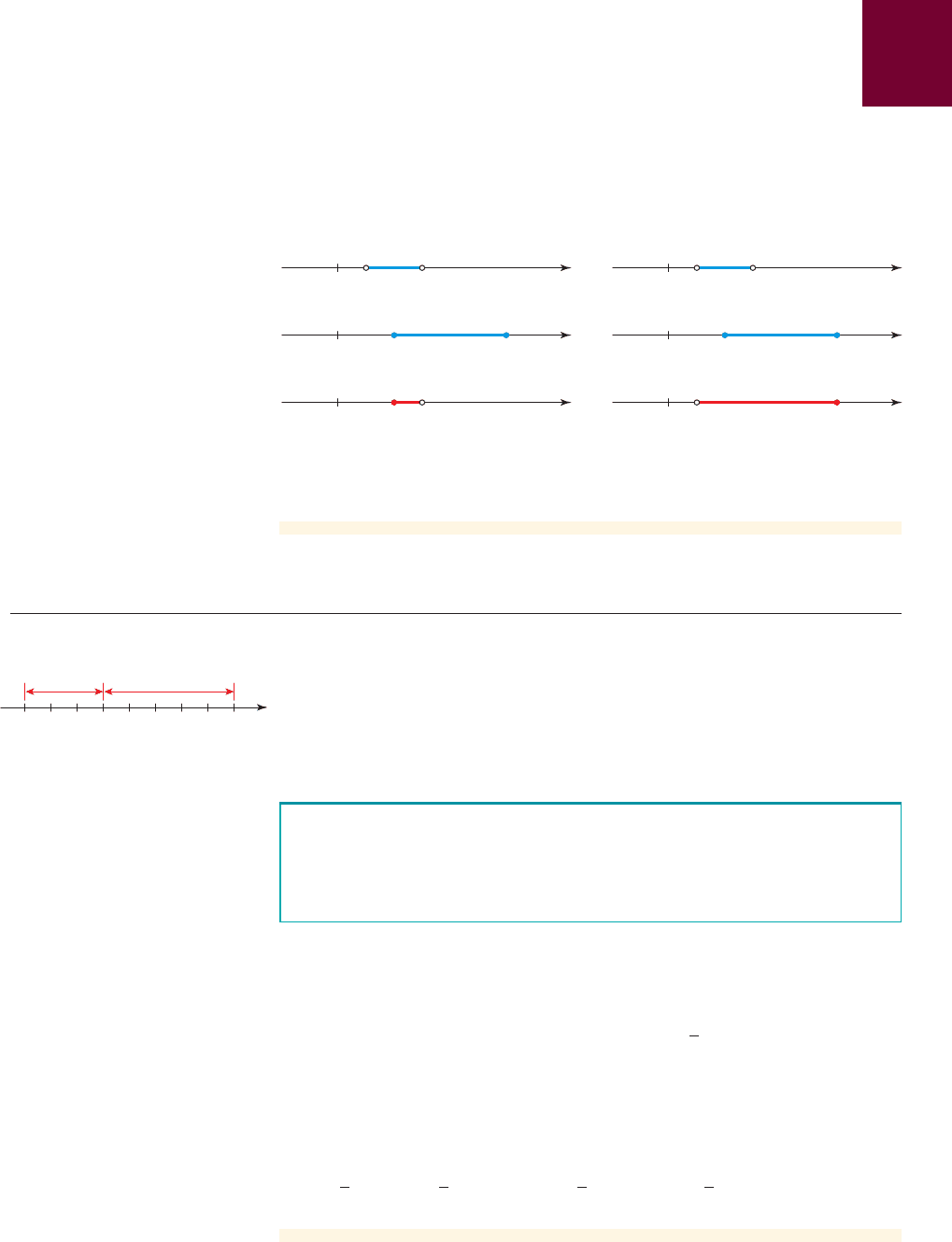
A.2
■
The Number Line and Intervals T11
This set is illustrated in Figure 6.
= 5x 0 1 6 x … 76= 11, 74
11, 32´ 32, 7 4= 5x 0 1 6 x 6 3 or 2 … x … 76
0
0
0
31
72
32
(1, 3)
[2, 7]
[2, 3)
figure 5
11, 3 2傽 32, 74
0
0
0
31
72
17
(1, 3)
[2, 7]
(1, 7]
figure 6 11, 32´ 32, 74
2
■ Absolute Value and Distance
The absolute value of a number a, denoted by , is the distance from a to 0 on the
real number line (see Figure 7). Distance is always positive or zero, so we have
for every number a. Remembering that is positive when a is negative,
we have the following definition.
Absolute Value
- a0 a 0Ú 0
0 a 0
If a is a real number, then the absolute value of a is
0
a 0= e
aif a Ú 0
- aif a 6 0
50_3
|5|=5|_3|=3
figure 7
example
6
Evaluating Absolute Values of Numbers
Evaluate.
(a) (b) (c) (d)
Solution
(a)
(b)
(c)
(d)
■ NOW TRY EXERCISE 59 ■
0 12 - 1 0 = 12 - 1 1because 12 7 1, and so 12 - 1 7 02
0 0 0= 0
0 - 3 0=-1- 32= 3
0 3 0= 3
0 12 - 1 00 0 00 - 3 00 3 0
■ NOW TRY EXERCISES 53 AND 55 ■
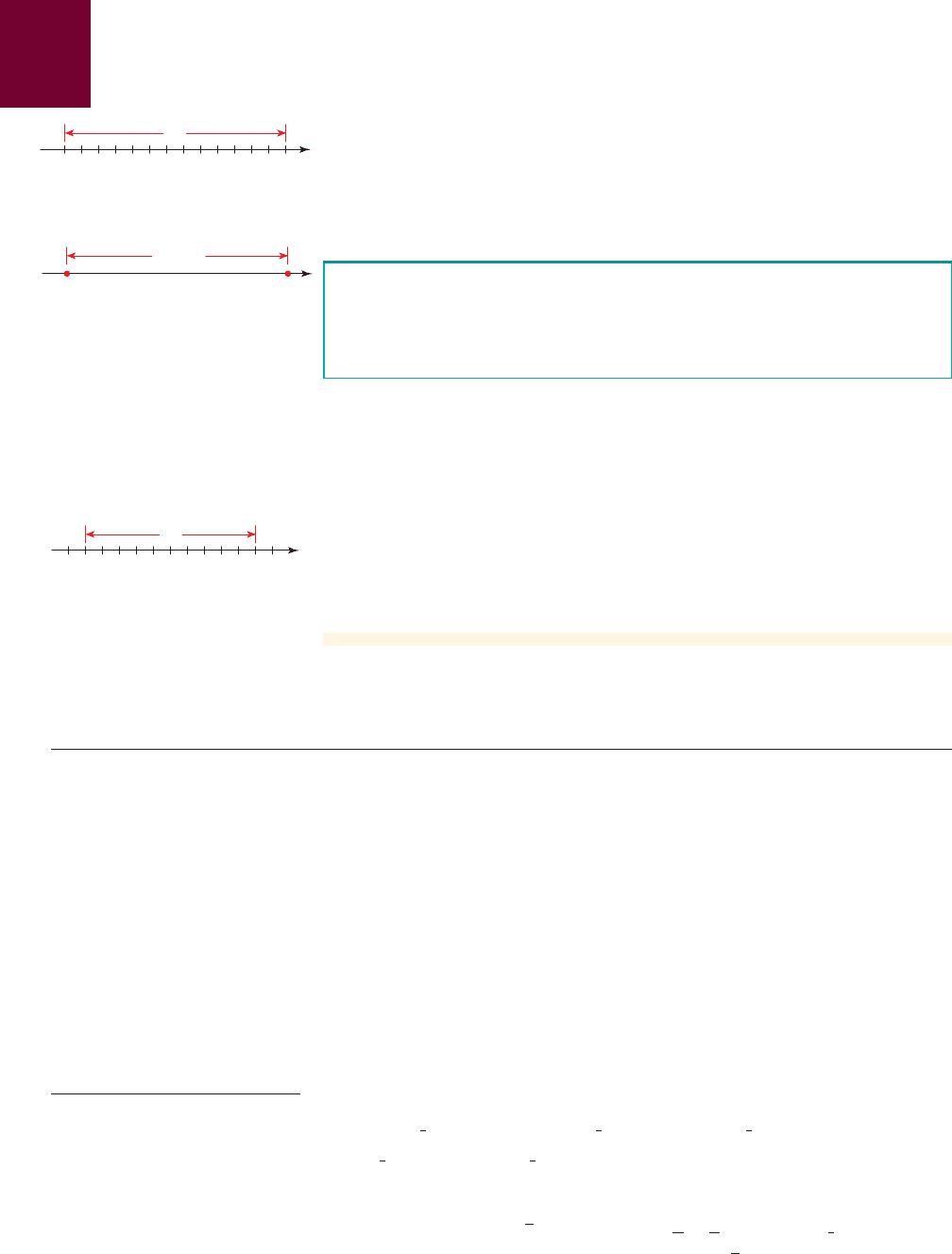
T12 ALGEBRA TOOLKIT A
■
Working with Numbers
110_2
13
figure 8
ba
|b-a|
figure 9 Length of a line segment
is 0
b - a 0
What is the distance on the real line between the numbers and 11? From
Figure 8 we see that the distance is 13. We arrive at this by finding either
or . From this observation we make the fol-
lowing definition (see Figure 9).
Distance Between Points on the Real Line
01- 22- 11 0= 13011 - 1- 2 20= 13
- 2
If a and b are real numbers, then the distance between the points a and b on
the real line is
d1a, b 2= 0
b - a 0
Note that . This confirms that, as we would expect, the dis-
tance from a to b is the same as the distance from b to a.
0 b - a 0= 0 a - b 0
example
7
Distance Between Points on the Real Line
The distance between the numbers and 2 is
We can check this calculation geometrically, as shown in Figure 10.
■ NOW TRY EXERCISE 63 ■
d1a, b 2= 0 - 8 - 2 0= 0 - 10 0= 10
- 8
20_8
10
figure 10
A.2 Exercises
CONCEPTS
1. Explain how to graph numbers on a real number line.
2. If , how are the points on a real line that correspond to the numbers a and b
related to each other?
3. The set of numbers between but not including 2 and 7 can be written as follows:
(a)
_____________ in set builder notation
(b)
_____________ in interval notation
4. Explain the differences between the following two sets: and
5. The symbol stands for the
_____________ of the number x. If x is not 0, then
the sign of is always
_____________.
6. The absolute value of the difference between a and b is (geometrically) the
_____________ between them on the real line.
7–8
■ Place the correct symbol in the space.
7. (a) (b) (c)
8. (a) (b) (c)
9–16 ■ State whether each inequality is true or false.
9. 10. 11. 12.
13. 14. 15. 16. 8 … 81.1 7 1.1
8 … 9- p 7-3
-
1
2
6-1
10
11
6
12
13
12 7 1.41- 6 6-10
0
0.67 0
ⵧ
0- 0.67 0
2
3
ⵧ
- 0.67
2
3
ⵧ
0.67
3.5
ⵧ
7
2
- 3
ⵧ
-
7
2
3
ⵧ
7
2
16 , 7 , or = 2
0
x 0
0
x 0
B = 1- 2, 52A = 3- 2, 54
a 6 b
SKILLS
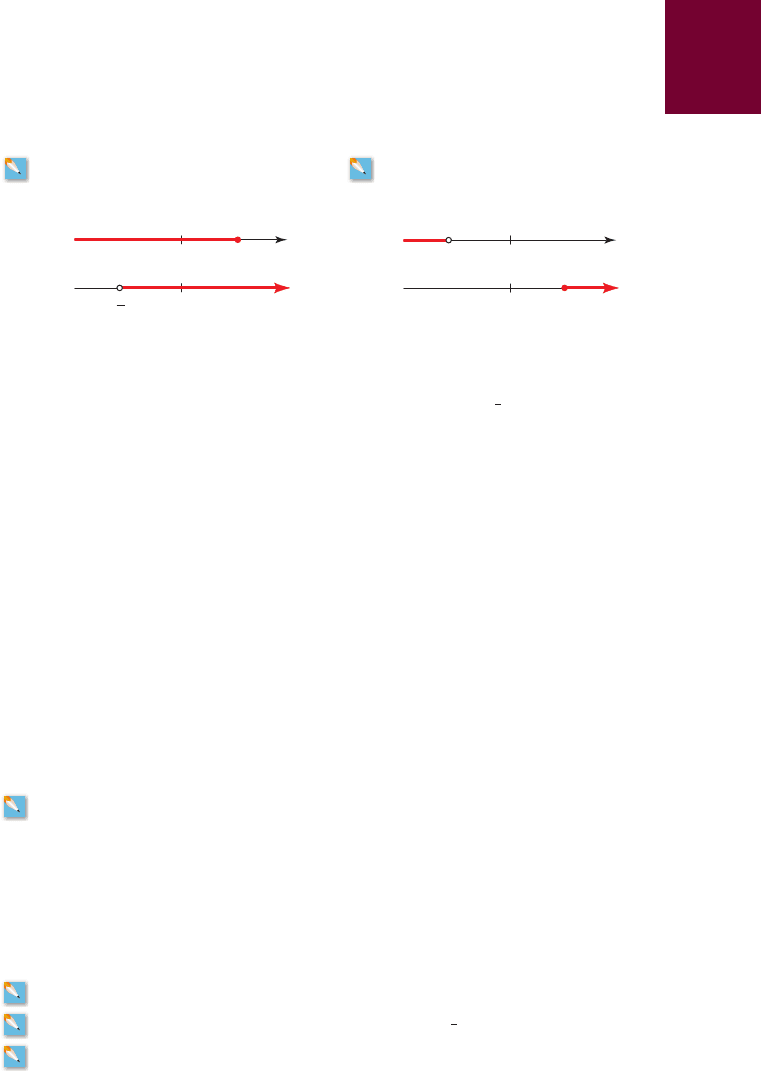
A.2
■
The Number Line and Intervals T13
10
_2
0
17–20 ■ On a real line, graph the numbers that satisfy the inequality.
17. 18. 19. 20.
21–24
■ Find the inequality whose graph is given.
21. 22.
23. 24.
25–26
■ Write each statement in terms of inequalities.
25. (a) x is positive. (b) t is less than 4.
(c) a is greater than or equal to . (d) x is less than and is greater than .
(e) The distance from p to 3 is at most 5.
26. (a) y is negative. (b) is greater than 1.
(c) b is at most 8. (d) w is positive and less than or equal to 17.
(e) y is at least 2 units away from 7.
27–30
■ Find the indicated set if , , and
.
27. (a) (b)
28. (a) (b)
29. (a) (b)
30. (a) (b)
31–32
■ Find the indicated set if , , and
.
31. (a) (b)
32. (a) (b)
33–40
■ Consider the given interval.
(a) Give a verbal description of the interval.
(b) Express the interval in set builder notation.
(c) Graph the interval.
33. 34.
35. 36.
37. 38.
39. 40.
41–48
■ Express the inequality in interval notation, and then graph the corresponding
interval.
41. 42.
43. 44.
45. 46.
47. 48. - 5 … x 6-2x 7-1
x … 1x Ú-5
- 5 6 x 6 2- 2 6 x … 1
3 6 x 6 51 … x … 2
3- 3, q 21- q, - 22
1- q, 1 232, q 2
3- 6, -
1
2
432, 82
12, 8 41- 3, 02
A 傽 CA ´ C
B 傽 CB ´ C
C = 5x
0 - 1 6 x … 56
B = 5x
0 x 6 46A = 5x 0 x Ú-26
A 傽 B 傽 CA ´ B ´ C
A 傽 CA ´ C
B 傽 CB ´ C
A 傽 BA ´ B
C = 57, 8, 9, 106
B = 52, 4, 6, 86A = 51, 2, 3, 4, 5, 6, 76
z
- 5
1
3
- 1
x … 0x 6-3x 7-4x Ú 1
_
0
3
2
05
